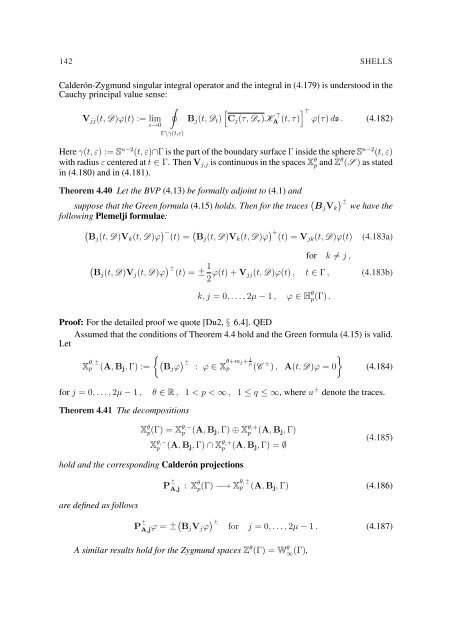EQUATIONS OF ELASTIC HYPERSURFACES
EQUATIONS OF ELASTIC HYPERSURFACES
EQUATIONS OF ELASTIC HYPERSURFACES
Create successful ePaper yourself
Turn your PDF publications into a flip-book with our unique Google optimized e-Paper software.
142 SHELLS<br />
Calderón-Zygmund singular integral operator and the integral in (4.179) is understood in the<br />
Cauchy principal value sense:<br />
∮<br />
[<br />
⊤<br />
V jj (t, D)ϕ(t) := lim B j (t, D t ) C j (τ, D τ )KA ⊤ (t, τ)]<br />
ϕ(τ) ds . (4.182)<br />
ε→0<br />
Γ\γ(t,ε)<br />
Here γ(t, ε) := S n−2 (t, ε)∩Γ is the part of the boundary surface Γ inside the sphere S n−2 (t, ε)<br />
with radius ε centered at t ∈ Γ. Then V j,j is continuous in the spaces X θ p and Z θ (S ) as stated<br />
in (4.180) and in (4.181).<br />
Theorem 4.40 Let the BVP (4.13) be formally adjoint to (4.1) and<br />
suppose that the Green formula (4.15) holds. Then for the traces ( ) +<br />
B j V<br />
−<br />
k<br />
following Plemelji formulae:<br />
we have the<br />
(<br />
Bj (t, D)V k (t, D)ϕ ) −<br />
(t) =<br />
(<br />
Bj (t, D)V k (t, D)ϕ ) +<br />
(t) = Vjk (t, D)ϕ(t) (4.183a)<br />
for k ≠ j ,<br />
(<br />
Bj (t, D)V j (t, D)ϕ ) − + (t) = −<br />
+ 1 2 ϕ(t) + V jj(t, D)ϕ(t) , t ∈ Γ , (4.183b)<br />
k, j = 0, . . . , 2µ − 1 , ϕ ∈ H θ p(Γ) .<br />
Proof: For the detailed proof we quote [Du2, § 6.4]. QED<br />
Assumed that the conditions of Theorem 4.4 hold and the Green formula (4.15) is valid.<br />
Let<br />
{<br />
X θ, − +<br />
(Bj<br />
p (A, B j , Γ) := ϕ ) }<br />
− + : ϕ ∈ X θ+m j+ 1 p<br />
p (C −+ ) , A(t, D)ϕ = 0 (4.184)<br />
for j = 0, . . . , 2µ − 1 ,<br />
θ ∈ R , 1 < p < ∞ , 1 ≤ q ≤ ∞, where u −+ denote the traces.<br />
Theorem 4.41 The decompositions<br />
X θ p(Γ) = X θ,−<br />
p (A, B j , Γ) ⊕ X θ,+<br />
p (A, B j , Γ)<br />
X θ,−<br />
p<br />
(A, B j , Γ) ∩ X θ,+ (A, B j , Γ) = ∅<br />
p<br />
(4.185)<br />
hold and the corresponding Calderón projections<br />
are defined as follows<br />
P −+ A,j : Xθ p(Γ) −→ X θ, − +<br />
p (A, B j , Γ) (4.186)<br />
P −+ A,j ϕ = − +( B j V j ϕ ) − + for j = 0, . . . , 2µ − 1 . (4.187)<br />
A similar results hold for the Zygmund spaces Z θ (Γ) = W θ ∞(Γ),

















